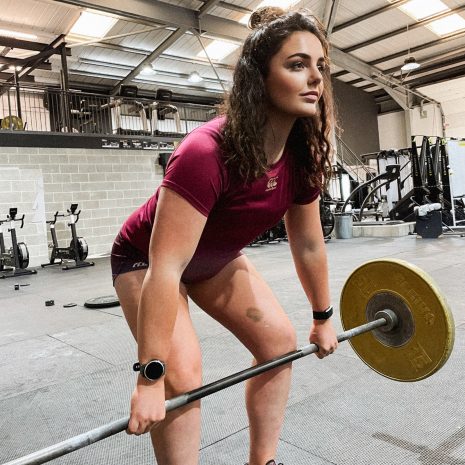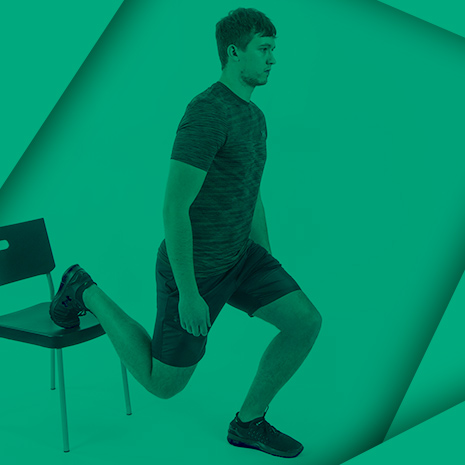We have teamed up with esteemed Chartered Physiotherapist, Neil Aitken to give you high-quality information on the most common Rugby injuries and how to best recover from them. If there’s a particular injury you’d like us to cover with Neil’s help, get in touch with us on social media (Facebook | Twitter).
What Are My Quadriceps And How Are They Injured?
The quadriceps, commonly known as the quads, are a group of muscles at the front of the thigh. They are called Vastus lateralis, vastus medialis, vastus intermedius and the rectus femoris. They act to straighten the knee and also help to flex the hip.

An injury to the quads could be to any of the four muscles but it is most commonly the rectus femoris. This is because it is the only muscle of the four to cross both the hip and knee joints. It is most likely that you injured this muscle when sprinting or kicking or another similarly high-stress activity for the muscle.
An injury would be classified from Grade 1 to 3 depending on how severe it is. It is important to rehab the quads really well as they provide the major part of stabilisation for the knee and are therefore vital in protecting you from knee injuries.
What Are The Differing Degrees Of Severity?

Grade 1
This is a mild strain of some muscle fibres. You may feel a sensation of tightness and a low level of pain when the quadriceps muscles are stretched or contracted. You may have been able to continue to run/play during the match, albeit with pain.
Grade 2
More muscle fibres are involved and the feeling of pain is higher. There may also be signs of swelling with bruising tracking out of the muscle after a few days. This will then move down the leg due to gravity. It is likely that you would have had to stop playing at the time of the injury.

Grade 3
A grade three strain is a more severe injury. There is an immediate burning or stabbing pain and the individual is unable to walk without pain. The injured section of the muscle has ruptured and there may be a large lump of muscle tissue above a depression where the tear is. This should be assessed by a physio/GP as although conservative management may be possible there may also be the need for surgery.
How To Treat Your Quadriceps Injury
As always, if you are concerned about the severity of your injury you should be assessed by a qualified person such as a physiotherapist or doctor. The following is a guide only. Each case is different and the management will therefore differ depending on the individual, their position and therefore role within the game and the severity of the injury.
The Early Days Of Injury
As with most injuries, the first 5-7 days is the time to limit damage and let the area settle. During this time the PRICE regime should be followed.

Protection, Rest, Ice, Compression and Elevation. Ice can be applied for 20 minutes every 2 hours. Protection and rest may involve the use of crutches to limit the use of the quads.
When Should I Start Rehab?
When to start your rehab will depend on the grade of the muscle strain. You could start rehab at 5 days if pain has settled or it may be a few weeks in more severe cases.
Strengthening is the most important factor. The muscle should also return to its normal length through stretching, rehab and general use. Strength training should incorporate gentle recruitment in the early stages through to peak power output both eccentrically and concentrically at end-stage rehab. This should involve plyometric exercises such as hopping/bounding/jumping. Endurance/fatigue should also be considered in your rehab.

As a basic guide the following exercises could be used as a progression:
The general rule is that there should either be no pain or only a low-level discomfort which settles quickly after the exercise. You should also feel no worse the next morning!
- Start with an isometric (static) quads contraction by straightening your knee and holding the thigh tight for 5 seconds. Repeat up to 10 times.
- Progress to through range exercises where your knee will move. An example could be sitting in a chair, raise your foot up in front of you, hold for 2-3 seconds and then slowly lower the foot back to the ground. Repeat 10 x 3.
- If day-to-day movements are becoming less painful then start sit to stand exercises. This is basically a squat. Stand up from a chair then slowly sit back down again. The lower the chair the harder it will be. Repeat 10 x 3.
- Once this feels okay try a single leg squat. You could also begin to add weight to a normal squat. Lunges can also be attempted, adding weight as able.
- At this point you may feel that you can start to jog, progressing the distance and speed as able.
- If the muscle is coping with this add plyometric exercises such as jumping/hopping/bounding.
- At this point you can return to rugby training.
The timeframe for progressing through these exercises will vary depending on the severity of your injury. It could be anywhere from 2 weeks to 3 months, each individual will recover at a different speed.
About the author
Neil Aitken is a Chartered Physiotherapist with a private clinic in Edinburgh. He has previous experience as a senior physiotherapist in the NHS and provided physio for one of the top amateur rugby teams in Scotland. He is highly evidence-based having completed a Post Grad in Musculoskeletal Physiotherapy gaining membership to the MACP, one of the most highly respected qualifications within physiotherapy.
Website: http://www.neilaitkenphysio.co.uk/
Facebook: https://www.facebook.com/neilaitkenphysio/
Twitter: @aitkenphysio

Please note, this article is intended to serve as a guide for general information only. Injuries should be assessed by a qualified specialist such as a physiotherapist or doctor. When you sustain an injury, there are always complicating factors that may need to be assessed and addressed by a professional.




Comments